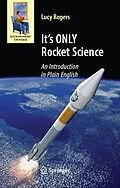"Well, it's not rocket science, is it?"
How many times have you heard people use that expression when they mean something pretty simple? There are other areas of science and technology that are arguably more challenging than rocket science, but no other (perhaps apart from brain surgery) has entered mainstream English vocabulary as a byword for 'difficult'.
But 'hard to understand' isn't the same as 'impossible to understand', as Dr Lucy Rogers - who is herself currently working as a rocket scientist - shows in this book.
She describes, in everyday terms and entirely without complex math, just what is involved in launching something into space, to explore the universe beyond our small planet. If you want to understand the fundamentals of space flight, from how to leave the Earth - including the design of the rocket and vehicle, mission planning, navigation and communication - to life in space and the effects of weightlessness, begin your journey here.
Autorentext
Dr Lucy Rogers is a Fellow of the Royal Astronomical Society and a member of the British Association of Science Writers. She is an engineer, and is currently working on the Launch Escape System propulsion unit for StarChaser, the UK's commercial space access company. She has published articles in The Guardian national newspaper, and on BBC Online.
Zusammenfassung
For over fifty years satellites have circled the Earth and spacecraft have been used to explore our solar system. Every day ordinary people around the world use satellites for satellite television, GPS navigation, weather forecasts and other technologies. Many people are curious about how something gets into space - and stays there - and what the terms used in the media actually mean. Also, with the advent of space tourism, some people are starting to wonder if they too could go into space and what it would be like.
Here, the author explains the basics of what is involved, from the initial idea to the completion of the mission.
The beauty of this text, written by an engineer who is also an accomplished science writer, is that it covers the subject comprehensively, and yet is almost entirely descriptive and non-mathematical.
It deals with all aspects of spaceflight, from how to leave the Earth (including the design of the rocket, mission planning, navigation and communication), to life in space and the effects of weightlessness.
The book also includes sections describing how an amateur can track satellites and understand their trajectories, and on the future of spaceflight, touching on what is, and what is not, possible given present and expected future technologies.
Inhalt
Rocket and spacecraft design: propellants, launch vehicles and spacecraft.- Mission planning and backup including choosing the launch site and supplies.- Navigation in three dimensions.- Communication.- Life in space (how humans cope).- Observing satellites: From naked eye observations to professional observatories.- Where to go (exploring the planets, the Moon, and further out).- What the future holds (different types of propulsion systems).- Glossary.- Index.
